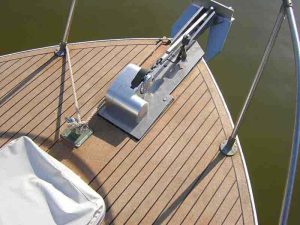How does cork compare to PVC and other faux-teak decking materials? While these alternative decking materials continue to gain in popularity, there are numerous reasons cork is superior.
Appearance
 Much effort has been put into making petroleum-based faux-teak materials look natural. It is up to the beholder to decide how effective those efforts have been, but it will help if your vision is less than perfect. Typically a little too uniform, and a little too orange for most people’s taste, faux-teak is close to the real thing. Maybe. Cork is completely unique, and while cork projects are often designed to incorporate black caulking joints to simulate the classic look of teak, and cork left in the sun will mellow to a stately gray the same as teak, the cork surface itself is quite different. Marked by interesting variations in color and size, there is no mistaking cork as a synthetic, petroleum-based product. From a distance it looks like teak. Close up, many think it looks even better.
Much effort has been put into making petroleum-based faux-teak materials look natural. It is up to the beholder to decide how effective those efforts have been, but it will help if your vision is less than perfect. Typically a little too uniform, and a little too orange for most people’s taste, faux-teak is close to the real thing. Maybe. Cork is completely unique, and while cork projects are often designed to incorporate black caulking joints to simulate the classic look of teak, and cork left in the sun will mellow to a stately gray the same as teak, the cork surface itself is quite different. Marked by interesting variations in color and size, there is no mistaking cork as a synthetic, petroleum-based product. From a distance it looks like teak. Close up, many think it looks even better.
Heat
This is the achilles heel of faux-teak materials in sunny southern climates and the tropics. These materials can become scorching hot, literally burning the feet of those on deck. Cork absorbs very little solar heat, maintaining a comfortable surface temperature, even on the hottest days (in practice only 10-20 degrees warmer than white gelcoat). Additionally, almost none of the sun’s heat is transferred to living spaces below deck, while PVC and other synthetics often add radiant heat to an already stuffy cabin.
Maintenance
“There are very few problems with cork one cannot sand their way out of.” Words to live by. Cork sheets and planks are 4mm to 12mm thick, allowing for numerous quick sanding jobs to return original color, or eliminate trouble spots. Someone drag something heavy or sharp across your deck? No worries, a quick sanding will make the mark disappear. Owners of PVC and other faux-teak decks find marks difficult to remove, with few options.
Keep in mind that Seacork is different from the cork flooring tiles you often see on the market, which are typically plywood or other baseboard material with a thin layer of cork on top for aesthetics. It is not recommended to sand these tiles often, if at all. Seacork is full-thickness natural cork, giving you much more flexibility, literally and figuratively.
Cost
Material cost of Seacork and these other alternatives is fairly close, but when you factor in the installation costs, and the cost to the environment, cork comes out a clear winner.
Environmental/Sustainability
This is where cork wins, hands down. PVC and other faux-teak products are nearly all petroleum-based, with all the baggage that comes with that. Not only is cork flooring itself a by-product of another industry, thereby saving cork scrap from the landfill, but the original harvesting of cork from the trees is a highly regulated, sustainable activity. Harvested on average every nine years, it is common for cork oak trees to live more than 200 years.
